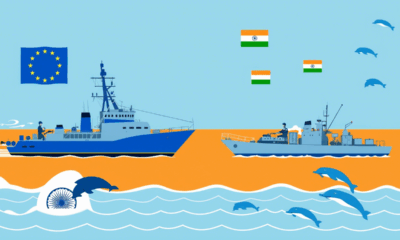Travel
‘Just not acceptable’: Miami Beach is breaking up with spring break – or at least trying to
Some civil rights advocates have claimed that the proposed changes are racially motivated.
Miami Beach in Florida is trying to break up with spring break – but it’s not yet clear whether spring break will take the hint.
The destination is infamous for its popularity as a spring break must-visit. Spring break is time off from University that usually falls around Easter in the US and other countries. Miami Beach is one of the most popular destinations with students.
The rite of passage began in the mid-1930s, when a swimming coach from Colgate University in New York state took his team down to Florida for some early training at a brand-new Olympic-size pool in sunny Fort Lauderdale.
Other colleges followed suit and the tradition emerged into what it is today: American students catching some sun during their break from study.
However, Miami Beach seems to have had enough of the influx.
After three consecutive years of violent incidents, officials are implementing month-long security measures aimed at curbing the chaos, including parking restrictions for non-residents and closing cafes on the main drag on busy weekends.
The city has warned visitors to expect curfews, bag searches at the beach, early beach closures, DUI checkpoints – as well as arrests for drug possession and violence.
What does the potential ban mean for Miami Beach residents and visitors?
Business owners in the city’s world-famous South Beach neighbourhood are now concerned, though, that they’ll lose money during one of the busiest times of the year.
Some civil rights advocates are also claiming that the restrictions are an overreaction to large Black crowds.
Many of the city’s restrictions aren’t new, but in past years, they were instituted as emergency measures during the unofficial spring break holiday – not measures put in place ahead of time.
“The status quo and what we’ve seen in the last few years is just not acceptable, not tolerable,” Miami Beach Mayor Steven Meiner said last month.
Meiner said crowds have become unmanageable despite a robust police presence. He added the city, which is situated on a barrier island across the bay from Miami, can only hold so many people – and that capacity has often exceeded what’s safe for both visitors and residents during the break.
Most spring break activity centres around a 10-block stretch of Ocean Drive known for its art deco hotels, restaurants and nightclubs.
David Wallack, owner of Mango’s Tropical Cafe, said Miami Beach has always thrived on celebration, and choking visitor access will turn the vibrant, eclectic city into a retirement community.
“I believe we need to create something big, another big event in March because March has fallen off the edge of the cliff,” Wallack told AP.
Wallack and other locals have proposed a large music festival during the third week of spring break – when aimless and unruly crowds tend to reach their climax – with the hope that attendees will disperse the loitering mobs.
Meiner, however, claimed the city has spent millions of dollars on concerts and other events in the past with little effect in mitigating the violence.
He added that businesses suffer when violent mobs gathering along Ocean Drive force them to close, adding that the people who are primarily causing the problems aren’t spending money in the city anyway.
“They’re not staying in the hotels,” Meiner said. “They’re not visiting our businesses.”
Why do civil rights activists think the changes are racially motivated?
Some civil rights advocates maintain that the restrictions are simply racially motivated.
South Beach became popular among Black tourists about two decades ago as promoters organised Urban Beach Week during the Memorial Day weekend.
Many locals have complained about violence and other crime associated with the event, which led to an increased police presence – but the event’s continued popularity correlates to a bump in Black tourism throughout the year.
Stephen Hunter Johnson, an attorney and member of Miami-Dade’s Black Affairs Advisory Board, said city officials are only cracking down so hard because many of the visitors are Black.
“Everybody loves this idea that they are free from their government intruding on them,” Johnson said. “But amazingly, if the government intrudes on Black people, everyone’s fine with it.”
Miami Beach’s mayor rejects the notion that the city’s actions have anything to do with race.
“I have a moral obligation to keep people safe, and right now, it is not safe,” Meiner said.
What is the spring break situation in the rest of Florida?
Also in Florida, the longtime spring break destination of Panama City Beach has experienced a similar escalation in violent crime over the holiday – but officials say it’s not down to students.
Police Chief Eusebio Talamantez instead attributes that to people taking advantage of the environment.
“When you think of spring break, you might think of vacation, a collegiate break, maybe some fistfights and some keg stands,” Talamantez said, “It has evolved into shootings, mass riots, rape and homicide.”
Panama City Beach’s violence came to a head in 2015 when a house party shooting left seven people wounded. The city subsequently banned alcohol on the beach and cracked down on unpermitted events.
Local businesses sued the city later that year, claiming the new rules unfairly targeted events popular with Black visitors, but the lawsuit was dropped several months later.
Talamantez said the measures were somewhat successful, but a massive hurricane in late 2018 and COVID-19 lockdowns in 2020 disrupted the city’s ability to manage crowds once pandemic restrictions were lifted, leading to a resurgence in the violence.
A renewed crackdown in 2023, however, led to a 44% reduction in crime – and the city is imposing similar rules this year. Talamantez said he doubts anything Miami Beach is doing will be more strict than the enforcement measures in Panama City Beach.
“We’re just trying to create an environment that says loud and clear in big bold letters that we are a municipality of law and order,” Talamantez said. “And law and order does not go away just because you’re on spring break.”
Travel
Hikers ignored warnings before Mount Etna’s latest eruption, Sicilian officials say
Published on
ADVERTISEMENT
Despite warnings to stay away, hikers on Mount Etna were forced to flee this week after Italy’s most active volcano erupted.
Footage from the mountain shared on social media showed tourists scurrying down the slopes as ash rose into the sky. Authorities had issued alerts on Monday morning after signs of increased volcanic activity, but dozens ignored them and climbed toward the summit anyway.
“There was a big explosion and a crater collapsed but luckily it fell into a deserted area,” said Salvo Cocina, head of Sicily’s Civil Protection Department. “It’s very hard to block access [to Mount Etna] – you can’t fence it off.”
No one was injured and the alert level was lowered to the standard ‘yellow’ on Tuesday.
Why is Mount Etna so popular with hikers?
Experiencing a close-up volcanic eruption is a bucket-list event, and Mount Etna offers one of the most accessible opportunities to do it.
At 3,350 metres tall and 35 kilometres wide, the Sicilian giant frequently rumbles to life, offering a front-row seat to nature’s raw power.
Even when it’s active, many trails and paths remain safe to climb.
“[The experience is] a mix of awe and adrenaline,” says mountain guide Saro Trovato, who safely – and legally – climbed Mount Etna when it erupted inFebruary.
“Even from a distance, you can feel the heat radiating from fresh lava flows.”
But above 2,500 metres, hikers are legally required to travel with a qualified mountain guide, who can keep visitors safe as well as informed.
On Tuesday, many hikers were as high as 2,700 metres above sea level.
How to stay safe when visiting Mount Etna
Conditions can change quickly on the mountain.
On Monday, a pyroclastic flow – a fast-moving surge of gas, rock and ash – travelled two kilometres down the mountainside. It didn’t go further than the Valle del Leone, a natural containment area for lava flows, but any changes could have led to catastrophe.
Tourism presents other problems during eruptions, too. In February, Cocina said that tourists parked on narrow roads around Mount Etna had blocked access for emergency vehicles. Firefighters had to be deployed to manage the growing crowds.
This is why the authorities mandate mountain guides such as Trovato, who receive real-time updates from volcanologists and rescue teams and are trained to respond if conditions suddenly change.
“Always check volcanic activity updates from local authorities and respect any access restrictions,” he advises. Especially when the volcano starts to stir.
Travel
Beyond the peloton: Cycling tourism is changing how we see and spend in Europe
ADVERTISEMENT
Across Europe, more travellers are choosing to see the continent from the bicycle saddle.
The once-niche endurance sport is now a growing form of low-impact, eco-friendly travel that’s gaining momentum as Europe embraces more sustainable ways to move and explore.
In fact, cycling tourism accounts for an estimated 2.3 billion trips across the EU each year, according to the European Cyclists’ Federation (ECF), from multi-day bikepacking adventures to leisurely riverside rides that go far beyond the city commute.
In honour of World Bicycle Day today, 3 June, there’s no better time to embrace a form of travel that’s as good for your well-being as it is for the world around you.
The rise of Europe’s two-wheeled traveller
A love for cycling is deeply embedded in Europe’s DNA. This is the continent of the Tour de France, Giro d’Italia and La Vuelta a España, after all. But the recent surge in two-wheeled travel isn’t about elite stage races alone.
Increasingly, everyday travellers are planning cycling holidays around slow, scenic routes that offer a more immersive, eco-friendly way to explore the world.
According to the ECF, cycling tourism now generates more than €44 billion annually and supports thousands of small businesses, from rural guesthouses to bike rental shops. In many cases, cyclists help extend tourism beyond the usual hotspots, bringing off-season or additional income to lesser-visited towns and regions.
And if you add in economic gains from better health and fuel savings, the ECF estimates that cycling produces €150 billion in total benefits for Europe.
The benefits of cycling tourism go beyond economics, too. Riding a bike even for short trips supports several of the United Nations Sustainable Development Goals (SDGs), from reducing carbon emissions to improving physical and mental health, and creating more inclusive and accessible transport systems.
It’s no wonder travellers are increasingly swapping long drives and flights foropen-air experiences that tread lightly and prioritise well-being.
How one initiative is driving change
At the heart of Europe’s cycling renaissance is EuroVelo, a continent-wide network of long-distance cycle routes designed to promote sustainable travel and build a better-connected Europe.
Once complete, the network will span nearly 61,000 kilometres, connecting the continent via 17 themed routes developed and coordinated by the ECF. As of 2023, over 56,000 kilometres were already in place, mostly along dedicated cycleways or quiet, low-traffic roads enhanced by new bike-friendly lanes.
Each route has a distinct identity. EuroVelo 1, the Atlantic Coast Route, hugs Europe’s western seaboard for more than 10,600 kilometres, running from northern Norway, across the UK and Ireland, through France and Spain and ending in Portugal.
EuroVelo 6, the Rivers Route, follows the Loire, Rhine and Danube through the centre of the continent before reaching the Black Sea.
And EuroVelo 13, the so-called Iron Curtain Trail, links former Cold War borders all the way to the edges of Turkey and Greece, turning a once-divisive line into a path of discovery.
New routes and new possibilities in the works
EuroVelo is continuing to expand across the continent.
In 2023, the ECF announced plans for EuroVelo 16, a nearly 1,900-kilometre Iberian Cycle Route. By 2028, the route will connect Lisbon and Pamplona with a journey through Alentejo, Toledo, Madrid and the foothills of the Pyrenees.
But other routes are proving just as popular. The 10-year-old Bay Cycle Way, a 130-kilometre path connecting Walney Island in Barrow-in-Furness with Glasson Dock in Lancaster, attracts three million riders a year, according to its founders, the Morecambe Bay Partnership.
Now, national governments are also stepping up. The UK announced nearly €355 million in funding in February to improve walking, wheeling and cycling infrastructure in England. The investment will add 300 miles of new routes, create safer crossings and provide free cycling training for hundreds of thousands of schoolchildren.
The city of Manchester is going a step further, aiming to make so-called ‘active travel’ routes widely accessible through its Bee Network of walking, cycling, bus and tram routes.
“Our plan to connect 95 per cent of our residents to within 400 metres of high-quality active travel routes is arguably the boldest in the country,” said Manchester’s mayor, Andy Burnham, in a statement.
As governments invest in cycle-friendly infrastructure and more travellers seek meaningful, lower-impact ways to explore, cycling stands out for its simplicity and reach.
Whether it’s a weekend ride along the Danube or a month-long journey from Norway to Portugal, cycling is becoming both a tourism asset and a public good that lets you experience Europe with fresh eyes and a lighter footprint.
Travel
Flying to the UK next year? New airspace design promises quicker journeys and fewer delays
ADVERTISEMENT
If you are flying to the UK next year or transiting through one of its airports, you should enjoy a smoother journey.
The government is promising holidaymakers quicker flights and fewer delays as part of laws introduced this week to open up new and more direct routes, propel airport expansion and boost growth.
The changes will enable the largest redesign of UK airspace since it was first formed in the 1950s. At that time, there were only around 200,000 flights per year, compared to 2.7 million in 2024.
The new UK Airspace Design Service (UKADS) will be fully operational by the end of 2025, according to the UK’s Department for Transport.
UK airspace redesign promises quicker flights
The UKADS’ initial focus will be on redesigning London’s airspace, with expansion at Heathrow airport alone expected to strengthen the UK’s status as a global transport hub and deliver major benefits for airlines and passengers.
Over a longer timeframe, the UKADS could design routes that support flight paths for new and emerging technologies such as drones and flying taxis.
“The measures will help secure the long-term future of the sector and make it more resilient to disruption,” says Aviation Minister Mike Kane. “The plans come as global forecasts show a near doubling of passengers and cargo in the next 20 years.”
Martin Rolfe, CEO of NATS, the air traffic service that will run UKADS, adds that the redesign will bolster an airspace network that is one of the busiest and most complex in the world.
“We handle a quarter of Europe’s traffic despite having only 11 per cent of its airspace, with one of the best safety and delay records anywhere,” he says.
“However, we have to modernise airspace if we are to maintain this level of performance as traffic grows towards 3 million flights per year.”
New UK airspace could cut flight emissions and noise pollution
As well as reducing flight delays, the UK government claims modernising the UK’s airspace will cut emissions per flight resulting from planes circling in the sky while waiting to land.
Redesigned ‘skyways’ could also allow planes to climb quicker during take-off and descend more smoothly, reducing noise and air pollution for residents who live along flight routes.
“Modernising our airspace is also one of the simplest ways to help reduce pollution from flying and will set the industry up for a long-term, sustainable future,” says Kane.
Tim Alderslade, CEO of Airlines UK, adds that improved resilience and reduced carbon emissions are a major priority for airlines.
“We look forward to working with ministers and all parts of UK aviation to complete a once-in-a-generation infrastructure programme as quickly as possible and ideally by the end of the decade, so we can continue delivering for passengers and cargo customers whilst meeting our commitment to net zero,” he says.
However, environmental groups say the overall effects of the overhaul will still be detrimental for the climate.
“There’s no doubt the aviation sector must change if we’re to tackle climate breakdown, but what’s needed is fewer flights, not more,” Friends of the Earth’s head of campaigns Rosie Downes said.
“It’s also likely that redesigning flight paths will expose even more communities to noise and air pollution, putting their physical health and wellbeing at risk.
“Instead of recklessly ploughing ahead with airport expansion in the midst of a climate emergency, the Government should be boosting investment in greener modes of travel like our crumbling rail network and disappearing bus services.”
-
EU & the World4 days ago
Aurora Borealis Forecast: Where & When to See the Northern Lights Tonight
-

 Sports5 days ago
Sports5 days agoChampions League Final 2024-2025: PSG-Inter, official lineups
-

 EU & the World5 days ago
EU & the World5 days agoRihanna’s Parents: About Her Late Dad Ronald Fenty & Mom Monica Braithwaite
-

 Sports6 days ago
Sports6 days agoPSG-Inter, Nicolò Barella jokes about Gianluigi Donnarumma
-

 EU & the World7 days ago
EU & the World7 days agoHailey Bieber’s Net Worth: How Much Money the Rhode Founder Makes
-

 EU & the World7 days ago
EU & the World7 days agoHow to Get the Sydney Sweeney Soap: About the Dr. Squatch Product
-

 Sports6 days ago
Sports6 days agoPSG-Inter, Lautaro Martinez unveils recipe for finals
-

 Politics6 days ago
Politics6 days agoEU and India Forge Deeper Maritime Ties with Historic Joint Naval Exercise in the Indian Ocean









